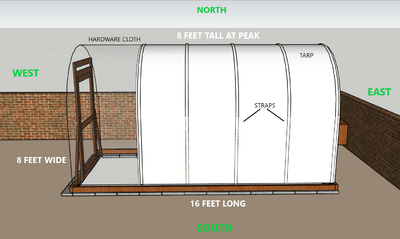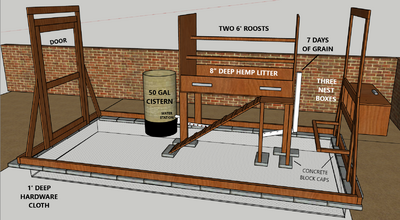I was inspired by Gallo Del Cielo's hoop coop and some videos by this couple. Please excuse my crappy Sketchup skills.
The basic construction is 1/4" hardware cloth and heavy duty tarp strapped down over cattle panels. The design is for 8-10 laying hens with 12.8 sq. ft. of ground surface area per hen (probably 4 EEs, 4 leghorns, and 2 buff orps). They cannot free-range due to the many hawks we have here. We also have coyotes, raccoons, skunks, bobcats, rattlesnakes, feral cats, and pack rats. The reason for hardware cloth going down 1 foot below the coop is because our yard is plagued with burrowing ground squirrels. Town code requires chicken coops to be predator proof. Basically the entire thing is a fully enclosed 1/4" hardware cloth cage. A wireless cam will help us keep an eye on the coop while we're inside our home. We live in the southern Arizona desert: very dry, hot, and barren.
I don't expect the inside of the coop to get soaked when it rains, which it rarely does, but we can get some serious summer monsoon downpours. The concrete block caps on the ground are there to keep the wood out of water and mud as much as possible if water gets in. We'll use pressure-treated wood anywhere it touches the ground. The plywood panels on either side of the 6' roosts should block water and wind.
The basic construction is 1/4" hardware cloth and heavy duty tarp strapped down over cattle panels. The design is for 8-10 laying hens with 12.8 sq. ft. of ground surface area per hen (probably 4 EEs, 4 leghorns, and 2 buff orps). They cannot free-range due to the many hawks we have here. We also have coyotes, raccoons, skunks, bobcats, rattlesnakes, feral cats, and pack rats. The reason for hardware cloth going down 1 foot below the coop is because our yard is plagued with burrowing ground squirrels. Town code requires chicken coops to be predator proof. Basically the entire thing is a fully enclosed 1/4" hardware cloth cage. A wireless cam will help us keep an eye on the coop while we're inside our home. We live in the southern Arizona desert: very dry, hot, and barren.
I don't expect the inside of the coop to get soaked when it rains, which it rarely does, but we can get some serious summer monsoon downpours. The concrete block caps on the ground are there to keep the wood out of water and mud as much as possible if water gets in. We'll use pressure-treated wood anywhere it touches the ground. The plywood panels on either side of the 6' roosts should block water and wind.







